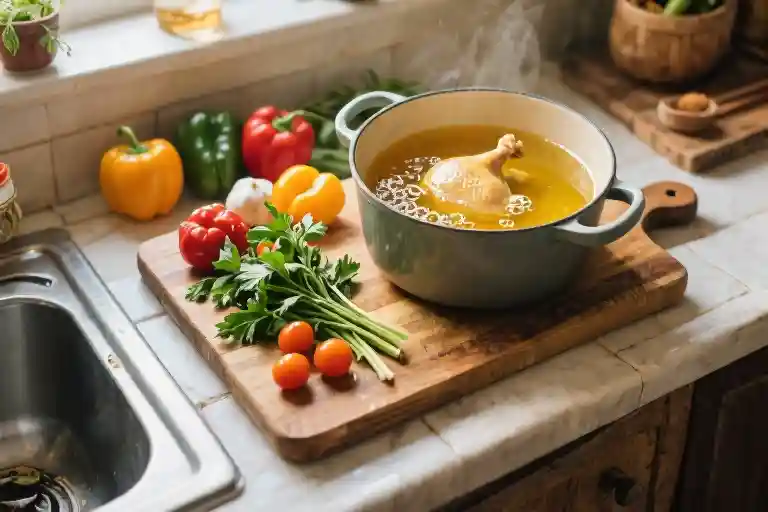The moment I realized my chef instincts had become second nature was when I found myself mentally reconstructing a client’s flavor profile while adjusting the straps of my twin baby carriers. There I was, balancing two toddlers against my chest and back, delivering a week’s worth of meals to a Hollywood producer’s home, simultaneously noting how the citrus notes in their previous order suggested a preference for bright, acidic flavors. This wasn’t just meal prep—it was culinary profiling, FBI-style, except my subjects were unsuspecting dinner guests and my crime scene was their taste buds.
Professional kitchen precision and the beautiful chaos of family cooking have always existed in tension for me. In restaurant kitchens, we measured ingredients to the gram and timed reductions to the second. At home, my cooking rhythm adapted to baby naps and toddler snack demands, where a perfectly seared salmon might get interrupted by a diaper emergency. Yet somehow, these two worlds collided into something unexpectedly useful—a way to create restaurant-worthy flavors with grocery-store budgets and preschooler-approved prep times.
What emerged from those early years of straddling professional standards and parenting realities was a peculiar survival skill: the ability to decode someone’s culinary preferences within minutes of meeting them, then translate that into affordable, doable meals. I’d watch how a friend took their coffee or what they picked from a cheese plate, building mental flavor maps that later informed dinner invitations. This wasn’t just chef’s intuition—it became my secret weapon for stretching food budgets without sacrificing that irreplaceable feeling of being thoughtfully fed.
The real test came when we moved back from LA, our income halved but our appetites undiminished. Suddenly my chef’s knowledge had to solve a new equation: how to make $5 dinners feel like something special. Those constraints birthed unexpected creativity—learning to amplify cheap cuts with long braises, turning vegetable scraps into rich stocks, discovering how a single expensive ingredient (like real saffron) could elevate an otherwise humble dish when used strategically. My professional training met maternal necessity, and the collision produced better cooking than either could have alone.
The Birth of a Feeder: From LA Private Chef to Stay-at-Home Mom
Moving back from Los Angeles with a toddler and another baby on the way, our food budget shrank overnight. The numbers didn’t add up – not if we wanted to keep eating real food while I stayed home with our kids. That’s when my old chef’s knife became my calculator, and our kitchen transformed into a laboratory for budget alchemy.
I started documenting our meals with grainy phone photos, the kind where you can see toddler fingerprints on the lens. Those imperfect shots became my first recipes – not the polished dishes I’d prepared for clients in LA, but honest food that made $3.50 chicken thighs feel celebratory. People responded to the realness. They saw their own kitchens in my sticky countertops, their own struggles in my quest to make canned tomatoes sing.
What surprised me most wasn’t that we could eat well on less, but how constraints bred creativity. That lesson became my culinary North Star: special isn’t about truffle oil or gold leaf. It’s in the crispy edges of a grilled cheese made with day-old bakery bread, or the way roasted carrots caramelize when you’re too distracted by a crying baby to pull them out on time. My professional training taught me technique, but motherhood taught me the alchemy of necessity.
Those early recipes shared three secret ingredients we all have in unlimited supply: attention, care, and context. A microwaved potato becomes a feast when served on the good plates with a dollop of sour cream swirled just so. The act of cooking – even scrambling eggs – transforms when you treat it as a love language rather than a chore. This became the heartbeat of my cooking philosophy: we’re not just feeding mouths, we’re nourishing souls.
My kitchen stopped being a stage for perfection and became a workshop for meaning. The burners were always on, both literally and metaphorically – simmering soups while rocking babies, testing spice blends during nap times. What began as financial necessity revealed itself as my true culinary education. The most important meals I’d ever make wouldn’t be served in fine dining rooms, but on plastic plates with sippy cups as centerpieces.
The Alchemy of $5 Dinners
There’s a particular kind of magic that happens when you stare into an almost-empty refrigerator. It’s not the magic of abundance, but the quiet thrill of constraint – the knowledge that with some bone broth and three random vegetables, I could make my family feel like we’re dining at a neighborhood bistro rather than counting pennies. This is the chemistry of budget cooking I’ve perfected over years of turning chicken bones into gold.
The Five Lives of Chicken Stock
Most home cooks see a carcass. I see a Russian nesting doll of possibilities. That pot of simmering bones on my stove isn’t just soup base – it’s a shapeshifter waiting to be deployed:
- The Foundation: Reduced by half with garlic and thyme, it becomes an intense glaze for roasted vegetables (cost per serving: $0.38)
- The Transformer: Whisked with miso and egg whites, it transforms into consommé worthy of a French kitchen ($0.27)
- The Comfort Agent: Thickened with day-old bread crumbs, it makes a velvety sauce for pasta ($0.42)
- The Emergency Kit: Frozen in ice cube trays with herbs, ready to rescue bland weeknight stir-fries ($0.15)
- The Diplomat: When combined with overcooked rice and a splash of vinegar, it brokers peace between picky eaters and leftovers ($0.31)
This isn’t frugality – it’s culinary jiu-jitsu, using the weight of limitation to flip expectations. The bones most people discard contain more flavor potential than the $8 organic chicken breast they carefully portion.
The Budget Flavor Matrix
I keep a mental radar chart comparing ingredients along two axes: cost density (flavor per dollar) and time efficiency (flavor per minute). Canned tomatoes score high on both – their umami-rich depth outperforms fresh tomatoes in winter at one-third the price. Parmigiano rinds? Flavor grenades that cost nothing at cheese counters if you ask politely.
Here’s the secret they don’t teach in cooking schools: Great flavor follows the path of least resistance. A $0.69 can of white beans, mashed with some of that reduced stock and a spoonful of mustard, makes a better dip than most $8 artisanal spreads. Not because it’s technically superior, but because its deliciousness-to-effort ratio is unbeatable when you’re simultaneously nursing a toddler and checking homework.
The 3-Ingredient Challenge
Tomorrow morning, open your fridge and play this game with me:
- Pick one protein (egg, canned tuna, that lone sausage)
- Pick one vegetable (even that half-wilted celery counts)
- Pick one flavor booster (mustard, soy sauce, hot sauce)
Now ask: How can these three things make each other better? That slightly soft carrot isn’t sad produce – it’s natural sweetness waiting to balance the saltiness of capers. The trick isn’t recipes, but learning to see ingredients as bundles of potential relationships. Last Tuesday, I turned frozen peas, stale cornbread, and a knob of ginger into a brilliant fritter that had my kids licking their plates. Total cost: $1.17.
What makes budget cooking truly satisfying isn’t just the money saved, but the creative muscles flexed. When my daughter asked why our “fancy rice” (made with stock, turmeric, and fried garlic chips) tasted better than her friend’s takeout, I didn’t mention the $3.50 price difference. I told her: “Because we cooked it with our brains first.”
The Mobile Kitchen: Cooking With Kids on Your Back
The baby carrier was my most essential kitchen tool for three straight years. I still remember the weight distribution calculations – 18 pounds on the front, 22 on the back, just enough counterbalance to chop onions without toppling over. Professional kitchens talk about mise en place, but my preparation involved pacifiers and teething toys alongside diced mirepoix.
The Ergonomic Chef
Through trial and (mostly) error, I developed a carrier-based cooking system:
- Front pouch: Reserved for younger infants, ideal for tasks requiring visual supervision like stirring risotto
- Back carry: Best for toddlers during high-heat operations, their curious hands safely distant from sizzling pans
- Hip position: The transitional stage for quick tasks like seasoning adjustments
The secret wasn’t just physical positioning, but syncing cooking rhythms with a child’s natural cycles. Those precious 15-minute post-nap focus windows became my culinary power hours.
The 15-Minute Kitchen Sprint
Here’s how I structured those brief productive bursts:
- Minutes 1-3: Retrieve pre-prepped ingredients from fridge (always stored at eye level to avoid bending)
- Minutes 4-7: Launch longest-cooking element (grains roasting, soups simmering)
- Minutes 8-12: Prepare raw components while main item cooks
- Final stretch: Quick assembly during the ‘I’m getting bored’ fussing phase
This wasn’t gourmet perfection – sometimes pasta boiled over while comforting a bumped knee. But the system delivered edible meals without relying on expensive takeout.
Safety as Second Nature
Parent-chefs develop spatial awareness that would impress NASA engineers. My kitchen developed invisible boundaries:
- The 24-inch danger radius: No child appendages within two feet of active heat sources
- The blade arc: Knives only moved away from tiny grabbing zones
- The splash zone: Hot liquids stayed on rear burners with pot handles turned inward
Oddly, these constraints bred creativity. I learned to flip omelets one-handed, use elbow-operated faucets, and develop recipes where occasional interruptions wouldn’t cause disaster (forgivable soups became my specialty).
What began as survival tactics became cherished rituals. My children’s first words included ‘hot’ and ‘yummy’ – not coincidentally, the two pillars of kitchen safety. Now when they stand on stools to help cook, I miss the weight of those carriers, the warmth of small heads nodding against my back as I worked. The kitchen was our first classroom, the smells and textures their introduction to the world’s delicious possibilities.
The Flavor Profiler’s Field Manual
Leftovers tell more truths than polite dinner table conversations ever could. That half-eaten plate of roasted vegetables with all the carrots picked out? A neon sign flashing “texture issues.” The soup with floating cilantro strands meticulously pushed to the rim? Someone’s genetic betrayal making cilantro taste like soap. This is where my FBI-agent-meets-chef brain kicks in—analyzing culinary crime scenes in my own kitchen.
Reading the Leftover Tea Leaves
Start with what’s not eaten before memorizing favorite dishes. My daughter’s abandoned broccoli florets at age three weren’t about taste—they were tiny trees perfect for catapulting off forks. The real clue? She’d devour the same veggie roasted until caramelized. Texture trumped flavor.
Keep a “waste log” for two weeks (a Post-it on the fridge works). Patterns emerge:
- Repeatedly untouched starches often mean portion control issues, not dislike
- Sauce separation (noodles eaten, sauce remaining) suggests improper coating
- Meat left at consistent doneness indicates overcooking preferences
Musical Taste Buds
Flavor preferences mirror music genres more than we realize. My metalhead husband? His palate craves distortion—umami bombs like fish sauce, smoked paprika, black garlic. My folk-singer sister? Acoustic flavors—single-origin olive oil, fresh herbs, subtle citrus.
Try this at home:
- Have family members pick their top 3 music artists
- Map to flavor profiles:
- Pop/Top 40 → Balanced, crowd-pleasing (think classic tomato basil)
- Jazz → Complex layers (mole sauce with 20+ ingredients)
- Hip-hop → Bold contrasts (sweet-spicy gochujang glazes)
- Test the theory with customized snacks
The Blind Taste Test Challenge
Professional tasting panels use score sheets, but your family version needs just three columns:
| Food Sample | Guess What It Is | Like/Dislike Notes |
|---|---|---|
| Pureed veggie #1 | “Weird applesauce?” | “Kinda earthy but sweet” |
Make it a game night:
- Blend cooked ingredients into uniform textures
- Serve in identical cups labeled A/B/C
- Award points for correct ID + thoughtful descriptors
Pro tip: Include one “decoy” item (like adding beet to hummus) to expose hidden sensitivities. My son detected the beet instantly—turns out he’s a supertaster.
Building Flavor Fingerprints
After a month of observations, I create “flavor IDs” for each family member:
Sample Profile: “Indie Rock Dad”
- Texture needs: Crunch factor required (adds nuts/seeds to everything)
- Floral avoidance: Skips rosewater desserts but loves lavender
- Acid seeker: Will add lemon to dishes that “don’t need it”
These become kitchen shortcuts. That chicken curry? Dad’s bowl gets extra lime wedges. Kids’ portions have golden raisins for texture play. No more cooking multiple meals—just strategic customizations.
The real magic happens when profiles intersect. My daughter’s love of sweet heat + husband’s umami craving birthed our house specialty: honey-sriracha glazed mushrooms with toasted coconut. Total cost: $3.50. Family food happiness? Priceless.
The Last Stir: Where Cooking Meets Connection
This isn’t where we say goodbye—it’s where your kitchen truly comes alive. That moment when my four-year-old stands on a stool, wooden spoon in hand, clumsily stirring pancake batter while flour dusts her eyelashes like snow—that’s the real secret ingredient I want to leave you with.
Join the #FlavorDetective Challenge
Here’s your first case file:
- Tomorrow morning, taste your coffee (or orange juice) with your eyes closed—what texture does the flavor “feel” like? Velvet? Sandpaper?
- Watch what your kid leaves on their plate tonight. Those rejected carrot coins? They’re not pickiness clues, but flavor preference data.
- Post your discoveries with #FlavorDetective. Tag me—I’ll profile your palate like we’re at a culinary crime scene.
The Messy Truth
That photo on my fridge still smells like burned onions: me in a sauce-stained apron, a baby on my hip stirring a pot with one hand while the other texts a client. The batter splatters aren’t Instagram-worthy, but they’re real. Your kitchen victories don’t need to be pretty. They need to feed—bodies and souls.
Your Kitchen Survival Kit
I’ve packed everything that saved me during the baby-wearing-cooking years into one downloadable PDF:
- The “$5 Dinner Matrix” (how to remix cheap staples)
- “15-Minute Kitchen Hacks” (tested by actual tired parents)
- Our family’s “Flavor Fingerprint” worksheet (track tastes like a detective)
Take it. Use it. Spill soup on it. That’s what it’s for.
Now go—your stove’s waiting. And when you inevitably burn the garlic? Welcome to the club. We meet every Thursday, covered in flour and laughing.





